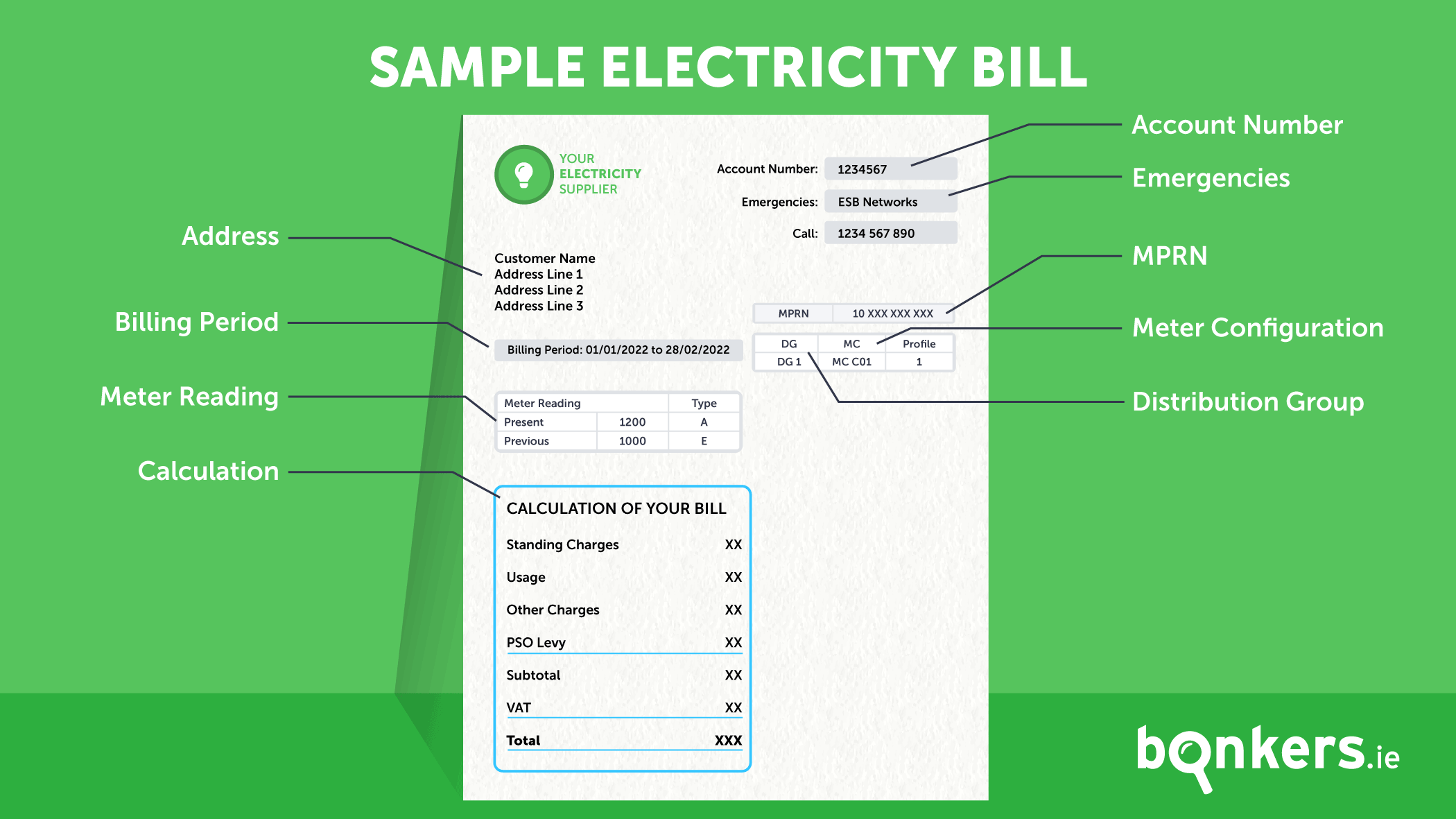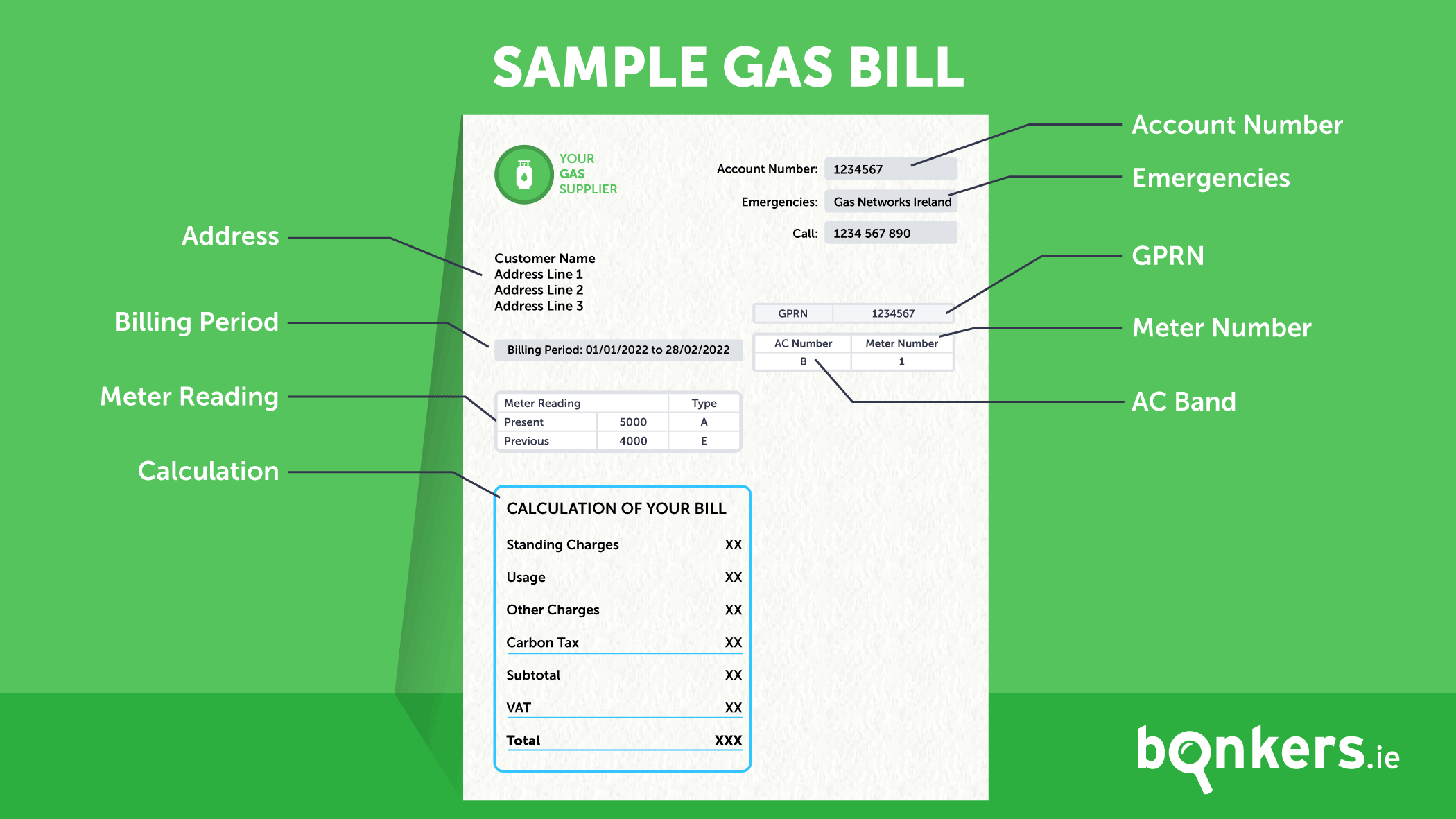Understanding all of the terms on your energy bill is important in order to know how to improve your energy efficiency and reduce your bills. Abbreviations such as kWh, E, GPRN and MPRN are explained in our guide to reading your energy bills.
This guide outlines how you can easily read and understand your energy bills.
It’s the fifth guide in our energy switching eight-part series, which aims to help you switch with ease using our energy comparison and switching service. You can find the rest of the guides in this series linked at the end of this article.
In order to switch energy supplier, you’ll need to have a recent bill on hand. Suppliers are required by the Commission for Regulation of Utilities to provide certain information on energy bills so that they’re easy to understand.
However we know that reading your bill can be difficult, so we decided to outline the terms commonly found on household energy bills.
It is important to note that bills from different energy suppliers vary, and they won’t all have the information outlined here in the same place.
Firstly, before we jump into what’s outlined on your energy bills, let’s have a look at some of the basic energy-related terms.
What is a kWh?
A kilowatt-hour (kWh) is the unit of measurement used by gas and electricity suppliers. One kilowatt-hour is equivalent to 1000 watts of energy used for 1 hour. For example, a 100-watt lightbulb switched on for 10 hours will use 1 kWh of electricity.
An average Irish household uses 14 kWh of electricity and 30.1 kWh of gas per day. One kWh will get you about 10 minutes in an electric shower or one cycle of your washing machine or dishwasher.
Take a look at this guide for further information on the national average energy consumption.
What is a unit rate?
A unit rate is the cost of electricity or gas per unit of energy used. Unit rates can vary from supplier to supplier. The unit rate will be displayed on your bill.
Your tariff name
The name of the tariff you’re currently on is often displayed on an energy bill, which you’ll need to know if you want to switch suppliers.
However, it is important to note that the names of tariffs are often changed by suppliers. To check if the name of your plan has changed you should contact your energy provider.
If all else fails, our comparison tool will provide you with an option to move suppliers even if you do not know the name of your tariff.
Reading your electricity bills
Households will receive an electricity bill from their supplier every two months and the following information will be outlined.
Account number
Your account number is usually displayed at the top of the bill and should be quoted when contacting your energy supplier.
Billing period
This is the timeframe for which your electricity usage is billed, which is about 60 days.
Address
This is the postal address you registered with your energy supplier. This is not necessarily the same address as where the energy is being used.
Meter reading
Your meter readings are used to calculate your bill. Both your current and previous readings will be displayed here. The type of reading may be indicated as:
- A - Actual reading
- E - Estimated reading
- C - Customer reading
What is an estimated reading?
‘E’ stands for ‘estimate’. It means that your energy consumption has been estimated, based on the average usage rate for a house similar to yours. Your consumption estimate determines your overall energy billing rate and it could be higher or lower than your actual consumption.
ESB Networks is responsible for reading your gas and electricity meter and tries to do so four times a year. However, if they were unable to get a reading from your meter, an estimation may be necessary.
It’s important to note that your actual consumption may be higher than your estimate, depending on what appliances are used in your home. You can discover what appliances use the most electricity here.
If you think you are paying for more electricity than you're actually using, you can provide your own meter reading to your supplier, either over the phone or online and they will then adjust your bill. Be sure to get in touch within two weeks of receiving your bill to get it changed!
If you haven’t had one installed already, Smart Meters are now available for customers and are being rolled out by ESB Networks. This new meter type means suppliers will no longer have to call around to take a meter reading, eliminating the need for estimated bills.
Find out more about Smart Meters with our guide here.
Distribution group
Your distribution group indicates whether you are an urban or rural electricity customer. Rural customers tend to pay more for their standing charge, as it costs more to supply electricity to properties further away from the network.
Whether you’re an urban or rural customer will be indicated by:
- DG1 - Urban domestic customers
- DG2 - Rural domestic customers
MPRN
Your MPRN is a unique 11-digit code that identifies your home’s connection to the electricity network. You’ll need this number if you want to switch electricity supplier.
You can learn more about your MPRN in this guide.
Meter configuration
MCC stands for meter configuration, which is a code used to describe the type of meter you have installed in your home, which measures the amount of electricity used.
Emergency contact information
Your supplier’s contact details will usually be at the top of the bill. If you have any questions or queries about your bill or are experiencing any difficulties paying your bill, you should get in touch with your energy supplier.
Calculation
Your bill will clearly outline the components that make up the total amount due. This is usually broken down to include:
- Standing charges: A standing charge is a fixed cost that is applied for each day of the billing period. A billing period is usually about two months or 60 days, but can vary. A low usage charge may apply if you use two units or less of electricity on average per day in a billing period.
- Usage: Your usage is calculated using your meter readings. Your electricity usage is measured by the difference between your current read and your previous read. Your supplier will multiply this by your tariff to calculate the charges on your bill.
- PSO levy: The Public Service Obligation (PSO) levy is a Government levy that is charged to all electricity customers in Ireland.
- VAT: VAT is charged at 13.5% to all electricity customers.
- Savings: Any discounts or savings will be displayed here.
- Other charges: From time to time there may be other charges on your bill, such as site works charges undertaken at your property by ESB Networks.
Reading your gas bill
Households will receive a gas bill from their supplier every two months. Gas bills look very similar to electricity bills and will also contain the following information:
- Your account number
- Your address
- The billing period
- Your meter reading
- Contact information for emergencies
It will also contain some information that differs from that of electricity bills.
GPRN
Your GPRN is a unique 7-digit code that identifies your home’s connection to the gas network. You’ll need this number if you want to switch electricity supplier.
You can learn more about your GPRN in this guide.
Annual consumption band
Your annual consumption band (AC band) will usually be displayed near your GPRN on a gas bill. It’s allocated based on your estimated annual gas usage.
You’ll see a letter associated with your estimated annual gas usage. There are five bands, as follows:
- A = Less than 6,000 kWh
- B = 6,000 kWh to 23,500 kWh
- C = 23,000 kWh to 73,000 kWh
- Y = 73,000 kWh to 750 MWh
- Z = 750 MWh to 5,500 MWh
Meter number
The number for your meter will be displayed near your AC band. If your meter is replaced, this number will change.
Calculation
Your bill will clearly outline the components that make up the total amount due. This is usually broken down to include:
- Standing charges: Like electricity, there’s a standing charge for gas. This is a fixed cost that is applied for each day of the billing period.
- Usage: Your gas usage is calculated using your meter readings. Your gas usage is measured by the difference between your current reading and your previous reading and is shown in cubic meters (m³). Your supplier will multiply this by the conversion factor to calculate the amount of energy used in kWh. This number is multiplied by the gas unit rate to calculate the usage charge on your bill.
- Conversion factor: This is used to convert the volume of gas (m³) used into the energy volume of the gas (kWh). The conversion factor fluctuates based on the energy content of the gas in the network. The conversion factor is calculated by Gas Networks Ireland.
- Carbon tax: The carbon tax is a charge applied to carbon-emitting fuels such as coal, peat, oil and natural gas.
- VAT: VAT is charged at 13.5% to all electricity customers.
- Savings: Any discounts or savings will be displayed here.
- Other charges: Occasionally there may be other charges on your bill, such as site works charges undertaken at your property by Gas Networks Ireland.
Reading your meters
How do I read my electricity meter?
The most common type of electricity meter in Ireland is a mechanical, or spinning disk, meter, which displays your consumption in kWhs. If there are two readings, one marked 'Day' and the other 'Night', then you have a special type of meter known as a NightSaver meter.
When reading your meter, you only need to take a note of the numbers in black and ignore the number in red. If you have a NightSaver meter, you will need to take note of both readings. The meter reading(s) will be used to switch you from one electricity supplier to another.
How do I read my gas meter?
When reading your gas meter, you only need to take note of the numbers in black and you can ignore the numbers in red. The meter reading will be used to close your gas account with your existing supplier and start your gas account with your new supplier.
Consult our thorough guide here on how to read your gas and electricity meter.
When did you last switch supplier?
The best way to save money on your bills is to compare current rates and switch to a better deal.
Use our energy comparison tool to compare the best deals today across all 13 energy suppliers nationwide.
Helpful energy articles
This is just one of the helpful articles in our nine-part energy switching guide series. You can check out the other guide below:
- This guide will give you a brief overview of the steps involved in switching.
- Discover how you can compare energy suppliers here.
- Read about how you can carry out the switch in this guide.
- Learn all about the energy cooling-off period in this guide.
- Get to grips with energy switching terms with this helpful guide.
- Check out our list of commonly asked switching-related questions.
- Aside from price, here are 7 things to consider when switching energy suppliers.
You can learn more about energy and the switching process over on our blogs and guides pages.
Here to help
If you have any questions about your energy bill or switching supplier, feel free to reach out to us on social media! We’re on Facebook, Twitter and Instagram.


